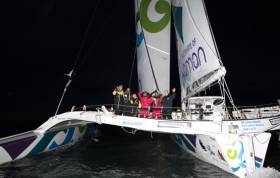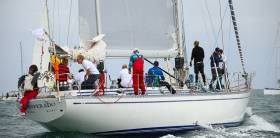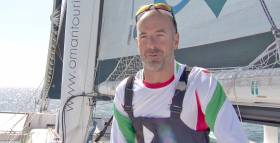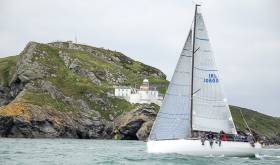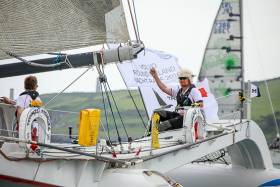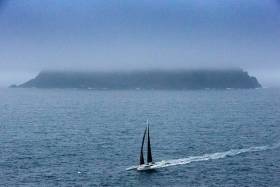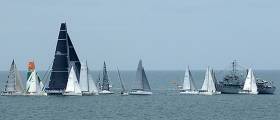Displaying items by tag: Round Ireland
Day 3 0600hrs Sidney Gavignet's Musandam-Oman Sail set an historic new record for the fastest-ever sail round Ireland when he crossed the Volvo Round Ireland Race finish line at Wicklow in just 38 hours, 37 minutes and 7 seconds smashing their own 2015 record by an incredible 2 hours, 14 minutes and 50 seconds. The new time is subject to ratification by the World Speed Sailing Record Council.
The Sultanate of Oman’s flagship trimaran was the first of three MOD70s to complete the full 704-mile course making good on pre–race predictions by Irish crew member Damian Foxall. (See pre–racce vid here). In a stunning finish on the Irish Sea all three MOD 70s broke the 2015 record.
“Even though we did it in record-breaking time, we had no rest. It was pretty full on. The only important part of leading the race is when you get to the finish line. Coming inside Howth we realised we could do it. I am exhausted!”, Foxall said after winning the MOD70 race.
Last night organisers were on tenterhooks as the three leading MOD 70 trimarans got within sixty miles of the finish at Wicklow by midnight. As Afloat's WM Nixon indicated last night 'Now we are looking at previously undreamed of statistics for the fastest time possible in a race as opposed to a staged record attempt'.
After a day and a half of racing, it came down to the last ten minutes to decide who were the winners as the giant multihulls neared the finish line off Wicklow harbour at dawn. The three seventy foot trimarans played cat and mouse all the way down the east coast in varying breezes from the south southwest. For those following this nail biting finish on the yellow brick tracker, they saw the 'crown' swapping between each boat to within a few miles of the finish.
The crews set off from Wicklow Bay at 13.10 on Saturday (18th June) for the 2016 Volvo Round Ireland Yacht race. Incredibly, all three of the Mod 70 trimarans arrived back to Wicklow within minutes of each other, every single one of them breaking the 2015 record.
Team Concise were out front for most of the race with Phaedo 3 overtaking them in the early hours of Monday morning, and it looked certain one of the two would take line honours. Musandam-Oman Sail however took advantage of an inshore track and manoeuvred ahead in the final hour.
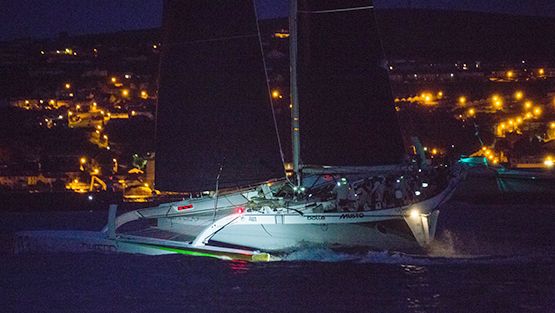
Phaedo 3 crossed the Wicklow line as second MOD70 Photo: Richard Langdon/Team Phaedo
Difficult seas meant 12 of the 63 yachts that set off on Saturday have since retired from the race. The remaining 48 are still making their way around the Irish coast, the bulk of them only half way round the course.
The next yacht expected in the monohull category is George David’s Rambler 88, which depending on winds is due in later today.
Musandam-Oman Sail crossed the @RoundIreland, taking line honours and beat their World Record. Well Done, Team! pic.twitter.com/mrvN4dv2Bk
— Oman Sail (@OmanSail) June 20, 2016
See Round Ireland tracker here and keep to up to date with the fleet's progress with Afloat's regular Round Ireland 2016 updates here
New Round Ireland Record Is Very Special For Damian Foxall
A Round Ireland record is something to be sailed at speed – and incredible speeds they are too these days – then recorded with precision, but in due course savoured and analysed at leisure writes W M Nixon.
At 0347hrs this morning off Wicklow, Sidney Gavignet’s MOD 70 Musadndam-Oman came to the finish line off Wicklow with sister-ships Phaedo 3 (Lloyd Thornburg) and Concise 10 (New Collier Wakefield) in close pursuit. The result for all three is a new round Ireland record which simply blows away all previous times.
But for Damian Foxall aboard Musandam, now the actual record holder, it was the sweetest moment. For it was he who persuaded Gavignet some years ago of the challenge of the round Ireland record, and he took part in no less than three attempts with the Frenchman on the Omani-backed boat. But all of them failed.
Then early in May 2015, Foxall was unavailable owing to other sailing commitments when Gavignet took on the 22 year-old record, and knocked nearly four hours off it. “Mixed feelings” barely begins to describe the Kerryman’s reactions on hearing of this.
Thus the Volvo Round Ireland Race 2016 with three MOD 70s taking part was definitely on Foxall’s “Must Do” list, but he was the first to admit that toppling the record of 2015 was decidedly ambitious, so simply finishing first was enough to be aiming at.
Certainly the early stages of the race were unpromising for any records, with the entire fleet - leading giant trimarans and ordinary offshore racers alike – having to turn to windward virtually the whole way from the Wicklow start at 1300hrs on Saturday June 18th to the most southerly turn at the Fastnet Rock.
When the trio of big trimarans finally got past the Fastnet at 0430hrs on Sunday, it was reckoned only an average sort of time, though good for the conditions with which they’d been contending. But for Musandan Oman, it was less than satusfactory, as they’d been persistently in third while up in front Ned Collier Wakefield with Concise 10 managed to say ahead of Lloyd Thornburg’s Phaedo, which had narrowly beaten the Concise team in the RORC Caribbean 600 in February.
Damian Foxall and Jean-Luc Nélias on the moment they took the lead Congratulations @OmanSail #vri2016 pic.twitter.com/kjur3Ji4KQ
— Round Ireland Race (@RoundIreland) June 20, 2016
These placings held good all the way round Ireland until Sunday evening, when they were crossing Belfast Lough after incredibly fast passages all the way up Ireland’s western seaboard, then all the way along the north coast and through the northern section of the North Channel between Ireland and Scotland.
For sure there were times when holes briefly appeared in the strong sou’west winds, and very occasionally speeds dropped down to 12 knots. But mostly they were in the 20-plus range, and on top of that the south-going flood tide right through the North Channel was giving them a significant boost.
The pressure was at bursting point, for now it was within the realms of possibility that they would be within shouting distance of the 2015 record when they get to Wicklow, even if they were gong to have to beat the 90 miles from the South Rock Light off the County down coast to the finish at Wicklow.
The first change in the order of things came before they’d passed Mew Island marking the southeast corner of Belfast Lough, when Phaedo finally started to show ahead of Concise 10. And once they’d started slugging directly into the wind beyond the South Rock, Phaedo’s relative position improved, but Musandam still stayed in third.
The Irish Sea can be surprisingly fickle in its wind patterns, so the tension as they tacked this way and that to maximize VMG was stratospheric. But around midnight things had settled down with them coming in on close quarters to each other towards the latitude of Rockabill, and the wind now veered slightly to give a small but helpful slant off the land. It was as Howth came abeam that Musandam showed clearly that she was relying on a more westerly option to find an advantage, and it came good south of Dublin Bay, as winds off Bray and Greystones were for a while all the place for the other two, but Musandam, having got herself right into the frame again, ploughed outside them into the lead with a private breeze.
It was a lead she held to the finish, a fairytale affair with all the boats across within minutes, and records tumbling left right and centre. As we write, Musandam-Oman is in the winner’s enclosure in Wicklow Harbour. Damian Foxall is only just grasping that it all happened exactly according to dreams, and way beyond plans and expectatons. And for the Volvo Round Ireland race organisers in Wicklow Sailing Club, only the first chapter in the great story has been completed.
A fantastic chapter it is too, but it’s only the first chapter. In an hour or so we’ll be looking at the next part of this incredible saga, analysing the chances of George David’s Rambler 88 breaking other records, as she currently has only 60 miles to go to the finish.
See Round Ireland tracker here and keep to up to date with the fleet's progress with Afloat's regular Round Ireland 2016 updates here
After 36 hours of racing the 63–boat Volvo Round Ireland fleet has been reduced by ten. Official retirals to date are:
1 Sun 12.30 Trilogic retired and returning to Dunlaoghaire – Gear sail problems
2 Sun 15.33 Xanadu retired to Kinsale – reason not specified
3 Sun 16,26 Medicare First Aid retired to Ballycotton – reason not specified
4 Sun 17.08 Andante retired to Dunmore East – reason not specified
5 Sun 17.07 Port of Galway retired to Crosshaven – Crew ill but nothing serious.
6 Sun 18.01 Applegreen Sail for Kids retired to Crosshaven – Gear problems
7 Sun 18.10 Denebola retired to Waterford – Autohelm damage
8 Sun 18.14 Desperado of Cowes retiring to Kinsale – Sail damage
9 Sun 18.40 Concise8 retiring to Crosshaven – reason not stated
10 Sun 20.27 May Contain Nuts retiring to Crosshaven – reason not stated
11 Sun 20.46 Fulmar Fever retiring to Dunmore East – reason not stated.

Applegreen sail for kids has retired into Crosshaven with gear problems. Photo: Afloat.ie
@RoundIreland safely tied up in the Royal Cork Yacht Club. Retired but safe #maycontainnuts #vri2016 #battered pic.twitter.com/OqGEEVzpTZ
— Ben Redwood (@nuts_sailing) June 19, 2016
See Round Ireland tracker here and keep to up to date with the fleet's progress with Afloat's regular Round Ireland 2016 updates here
Three high speed MOD70s are closing in on the Volvo Round Ireland Race finish line at Wicklow, for what might yet be a record breaking time, early tomorrow morning. In an exclusive pre–start video (below) for Afloat.ie, Digby Fox interviewed County Kerry sailor Damian Foxall onboard Round Ireland record holder Musandam Oman, currently off Rathlin Island.
In this video, Foxall, a Volvo Ocean Race winner, who has sailed eight round the world races, reveals he has never sailed Round Ireland! And Foxall's crew–mates, including skipper Sidney Gavignet, give an insight into sailing the fastest boats in the world and the importance of their 2015 record.
See Round Ireland tracker here and keep to up to date with the fleet's progress with Afloat's regular Round Ireland 2016 updates here
Day 2 1730hrs: According to many weather forecasters, right now we should be getting a fine hearty breeze from the south to southwest all along the south coast as the day’s rain clears to the eastward writes W M Nixon. Yet a quick reference to wind reports from Roche’s Point shows that at 1634hrs there were light southeast to east breezes in the immediate area.
Off the entrance to Cork Harbour, a cluster of boats in the Volvo Round Ireland Race are finding it difficult to get their speeds above 5 knots, even though offshore the underlying wind is in the expected direction. But there’s just not a lot of it. Even the mighty Teasing Machine (Eric de Turckheim) still has to get to the Fastnet, though she is closing in on it and in recent minutes her speed has gone up from less than 6 knots to 7. She is still at the top of the IRC leaderboard, first in class and second overall to Rambler 88, which is finding all the wind she wants as she sweeps past Eagle Island at 23.8 knots.

Oman sail – her 2015 Round Ireland speed record is under pressure if current predictions hold true tonight
The reality is that we are now looking at four different races. Firstly, there’s the contest of the MOD 70s, which passed the most northerly point at Inishtrahull with Ned Collier Wakefield in command of Concise 10 leading with five miles in hand on Lloyd Thornburg’s Phaedo 3 and eight miles on Sidney Gavignet’s Musandam Oman (See video interview with Oman Sail's Irish crew Damian Foxall). Concise 10’s performance has been remarkable as Phaedo was able to keep her under close control and astern during the RORC Caribbean 600 in February, yet from an early stage in this race Ned Collier Wakefield and his team have got ahead and stayed there, often by quite substantial distances, but even as we write their speed has dropped to 16 knots while the other two are still in the 20s.

In IRC 4 division the J97 Lambay Rules (Stephen Quinn) from Howth is lying second
Ether way, the new flood tide into the North Channel will barrel them along all the way to the South Rock Light off the County Down coast, but thereafter they may find the Irish Sea serving up headwinds for the final eighty miles to Wicklow. A toppling of Sidney Gavignet’s unlimited record, set in May 2015, of 1 day 16 hours and 51 minutes is possible as they’d have to be finished by 8 o’clock in the morning, but even while we’re writing this they’ve got to Rathlin Island, so who knows?
The second “Race Within A Race” is simply Rambler 88 racing against herself and striving to better both Mike Slade’s race record with Leopard in 2008 of 2 days 17 hours and 48 minutes, and Jean-Philippe Chomette’s 2006 open record of 2 days 9 hours and 41 minutes with the Open 60 CityJet/Solene. While the latter seems increasingly unlikely, the former is still eminently do-able. Meanwhile, as Rambler has enjoyed more breeze - and a fair wind at that - than the rest of the mono-hull fleet for all of today so far, she is well ahead in IRC 1 overall.
The third “Race Within A Race” is really the Volvo Round Ireland Rae as most of us know and understand “normal” modern offshore racing, as it’s the rest of the typical 21st Century fleet which is now spread out between Teasing Machine at the Fastnet and Fulmar Fever, Robert Marchant’s Fumar 32, close southeast of Ardmore in West Waterford.
At times the sailing has been more than very rugged, and the First 40 Medicare First Aid (Joe Conway) has retired into Ballycotton, while the Dehler 37 Port of Galway (Martin Breen & Nigel Moss) has pulled into Crosshaven though her retiral is not yet officially confirmed, while Keith Miller’s Yamaha 36 Andante also looks to be heading for home. These are in addition to the first two retirements reported by Afloat.ie earlier this afternoon.
But among those still in the hunt, the placings at 1800hrs Sunday are:
IRC Overall: 1st Rambler 88 (George David), 2nd Teasing Machine (Eric de Turckheim, 3rd Euro Car Parks (Dave Cullen), 4th Mojito (Peter Dunlop & Vicky Cox), 5th Lisa (Michael Boyd, 6th Sarabande (Robert Mabley).
IRC 1 1st Teasing Machine, 2nd Lisa, 3rd Katsu (Alan Hannon)
IRC 2 1st Sarabande, (Robert Mabley) 2nd Aurelia (Chris & Patanne Power Smith, 3rd Fujitsu (Donal Ryan)
IRC 3 1st Euro Car Parks, 2nd Mojito, 3rd Rockabill VI (Paul O’Higgins).
IRC 4 1st Groupe 5 (Patrice Carpentier), 2nd Lambay Rules (Stephen Quinn), 3rd Cavatina (Ian Hickey).
Two-handed: 1st Groupe 5, 2nd Bellino (Rob Craige), 3rd Just Plain Crazy(Ian Knight)
Two particularly outstanding performances during today have been put in by Groupe 5 (Patrice Carpentier), a Sunfast 3200 which is leading both her open class and the two-handed division, and the J/109 Euro Car Parks (David Cullen) which has been reinforcing the Lazarus act which began in the small hours, and currently is pacing confidently with larger boats down off Seven Heads.
As for the fourth “Race Within A Race”, that is of course another boat racing with herself, but the 1937-vintage 43ft gaff ketch Maybird (Darryl Hughes) could not be more different from Rambler 88. Yet she is still slugging gallantly away, having finally put the Coningbeg Light off the Saltees astern, so if you’re in contact with any of Maybird’s crew, do send them some words of encouragement.
See Round Ireland tracker here and keep to up to date with the fleet's progress with Afloat's regular Round Ireland 2016 updates here
Two Round Ireland Race Retirals After 24 Hours Racing
Day 2 1000hrs: After 24 hours of racing in the Volvo Round Ireland Race office there have been two retirals, one multihull and one monohull from the total fleet of 63–boats racing.
Multihill skipper Hugo Smythe from the entry Trilogic reported that he was retiring 'due to gear and sail difficulties' and is heading for his home port of Dún Laoghaire. As Afloat.ie reported previously, the entry was the only Irish multihull in the race.
Skipper of the X50 Xanadu Simon Costain has notified the race organisers he is retiring and heading for Kinsale
See Round Ireland tracker here and keep to up to date with the fleet's progress with Afloat's regular Round Ireland 2016 updates here
Day 2 1000hrs: As anticipated in our midnight posting writes W M Nixon, the imminent onset of the stronger ebb in the Tuskar Rock/Carnsore Point area favoured the smaller boats in the 63-strong Volvo Round Ireland Yacht Race fleet, and this morning even the seemingly unassailable Teasing Machine (Eric de Turckheim), although still leading the main bulk of the fleet on the water and continuing to hold the lead in IRC 1, had slipped to 11th overall in IRC as she continued to slug along to windward on port tack well offshore, upwards of 30 miles south of Ballycotton.
But up in the far front of the fleet, the three MOD 70s were passing Mizen Head by 0400hrs and starting to make serious speed. As already noted briefly this morning on Afloat.ie, Phaedo (Lloyd Thornburg) and her two sisters had ticked off the Skelligs by 0600hrs, and with speeds of 25 knots they’re already in the larger coastal region of Connacht, though the lack of visibility in facilitating any enjoyment of the coastal scenery doesn’t apply, as they were shaping up to be at least 50 miles off Slyne Head to keep keep their westing and stay in the freshening southwest winds as firmly as possible.
George David’s Rambler finally got the Fastnet astern at 0845 this morning, and with the overnight soft winds of the south coast now very much a thing of the past, the big silver machine was logging 18.4 knots as she streaked past Mizen Head at 0920, and we’ll be expected much higher speeds from her as the sou’wester builds through the day.
This means that in a very short space of time Rambler has gone from zero to hero, as the most recent IRC overall placings have her hurtling back up the rankings to be overall leader in IRC. But for the time being, the little ’uns are still hugely enjoying the benefit that strong ebb off the south Wexford coast gave them through the small hours and beyond, and as of 0945 second overall in IRC was one of the smallest boats in the fleet, and a two-hander at that, Derek and Conor Dillon’s Dehler 34 Big Deal from Foynes, while third overall is the First 34.7 Adelie (Peter Hall & Noel Butler) of the National YC.
However, the benefits of the night’s localised tidal boost is already fading in the overall reckonings, for even as we’ve been writing this Teasing Machine has moved back up again, from 11th to fourth overall. And though it will be some time yet before she can think of freeing sheets a smidgin to make on with increased speed from the Fastnet to Mizen Head, barring accidents she’ll be the first of the main part of the IRC fleet to get to the corner, which will give her a massive advantage therafter. She may even still be ahead of the Open 40s, a position she has narrowly maintained through the night, but that will change once the Open 40s can let themselves go.

The current class placings are just grand as far as this correspondent is concerned, as they include a useful proportion of the “Ten Boats to Watch” we named in yesterday morning’s Sailing on Saturday. IRC 1 currently has Teasing Machine, Michael Boyd’s First 44.7 Lisa (above) and Alan Hannon’s Reichel-Pugh 45 Katsu (below) as the top three, in IRC 2 Chris and Patanne Power Smith’s J/122 Aurelia is first, currently tacking close inshore in Youghal Bay, while second and third are boats we didn’t name, the J/111 Team Fujitsu (Donal Ryan) and the vintage Swan 47 Sarabande (Rob Manley). But in Class 3 we’re currently managing a clean sweep with the J/109 Mojito (Peter Dunlop & Vicky Cox) leading from Paul O’Higgins new JPK 10.80 Rockabill, while third is Dave Cullen’s J/109 Euro Car Parks, back from the dead after being down in the crab grass at midnight.


Class 4 is of course very much led by the superb performance of the Union Chandlery–sponsored Conor and Derek Dillon (above) with the Big Deal while Adelie is second while Ronan O Siochru’s Irish Offshore Sailing’s Desert Star – top placed Irish boat in the 2015 Rolex Fastnet Race – is third, currently laying on starboard tack in towards Ardmore Bay.
But things are happening quicker than we can write about them. At 1000hrs, Rambler 88 is up to 21 knots and zooming past Dursey Head, while Teasing Machine is now laying the Fastnet with 8.2 knots on the clock, and back at second overall in IRC. And up off the Galway coast, the three MOD70s have thrown a gybe and are now shaping towards Achill Island at 30 knots, with Concise 10 still narrowly ahead.
See Round Ireland tracker here and keep to up to date with the fleet's progress with Afloat's regular Round Ireland 2016 updates here
Round Ireland Trimaran Phaedo3 Passes Skelligs At 25–Knots
Day 2 6am: During the night MOD70 trimaran Phaedo3 held onto to its second place on the water in the Volvo Round Ireland Race 2016. The three trimarans are led by British MOD70 entry Team Concise. This morning the Lloyd Thornburg Phaedo3 crew passed close to the island location for the next Star Wars movie on the South West coast, flying by the Skellig Islands making an average speed of 25–knots at 6am this morning. It’s still early stages in this 700–mile long distance race with Phaedo3 now close to the lead at 31–knots off Loop head in Co. Clare.
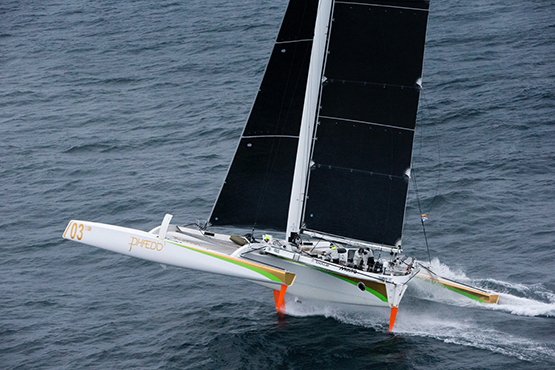
See Round Ireland tracker here and keep to up to date with the fleet's progress with Afloat's regular Round Ireland 2016 updates here
Day 1 2350hrs: The longest beach in Ireland runs south along the Wexford coast from Cahore Point all the way down to Wexford harbour itself writes W M Nixon. It’s pushing towards twenty miles and more in length, but through the late evening and early part of tonight, it has seemed considerably longer for the main part of the fleet in the Volvo Round Ireland Yacht Race.
They’ve struggled with sometimes fickle wind and a foul tide, and the mood has not been improved by a belt of rain from the west which is only just clearing the last of the fleet. Nevertheless those who held in close along the shore inside the banks down as far as Blackwater Head before allowing their course to shape itself towards the Tuskar undoubtedly did better than those who went seaward in search of a better breeze. Thus in the overall placings at 2330, one notable slippage through keeping east has been with Dave Cullen’s J/109 Euro Car Parks, which in our previous report at 1815hrs was lying third overall in IRC – now she’s lying 26th as she passes the Tuskar.
The biggies up at the front of the fleet – the three MOD 70s and Ramber 88 – elected to hold on starboard tack far out into the middle of nowhere, with the MOD 70s sharpening each other all the time by being only a couple of miles apart, though Team Concise continues to hold a narrow lead. But even as we’re putting this report together, they’ve tacked in unison, and are just about laying the Fastnet Rock, though speeds are nothing great by MOD 70 standards - we’re talking “only” 12 knots or so.
To the northeast of them, now about 35 miles astern, Rambler 88 is still on starboard and making 12.9 knots, but she has slipped to 17th overall in IRC, whereas Eric de Turckheim’s wonderful Teasing Machine – likewise ploughing along on starboard well off the Irish coast – continues to stay narrowly ahead of a trio of Open 40s, and is hanging in there and then some on IRC, as she is leading IRC I and Overall.

Noel Butler (on helm) and Peter Hall and crew on the Beneteau 34.5, Adelie are top Irish boat as the first day of Round Ireland 2016 draws to a close
The J/109 Mojito (Peter Dunlop & Vicky Cox) from Pwllheli is currently second overall, and in third are Peter Hall and Noel Butler with the First 34.7 Adelie, currently tops of the Irish boats with Stephen Quinn and his J/97 Lambay Rules in fifth. Or rather, that was the situation five minutes ago – now Lambay Rule lies second overall, which will have them dancing in the streets out in Howth. She seems to be doing well by taking a little tack in towards Carnsore Point after clearing the Tuskar.
Soon the new ebb tide will be giving a mighty boost to the smaller boats back in the Tuskar-Carnsore area, and that will probably provide us with another significant shakeup of the placings for the morning. But for now, Teasing Machine is marching along hard on the wind at 6.6 knots over the ground, with quite a good comfort margin between her and the next boat.
See Round Ireland tracker here and keep to up to date with the fleet's progress with Afloat's regular Round Ireland 2016 updates here
How to Make a Start in a Big Boat – Lessons 1 to 7
The nearer you were to today’s start of the Volvo Round Ireland Race 2016, the more amazing it all seemed. Yet it was difficult to see clearly what was happening as Teasing Machine and the mighty Rambler 88 came slicing through gaps which hadn’t even existed ten seconds earlier. Seen from a distance, it still looked both utterly marvellous – and totally scary. Photos: W M Nixon
See Round Ireland tracker here and keep to up to date with the fleet's progress with Afloat's regular Round Ireland 2016 updates here






























